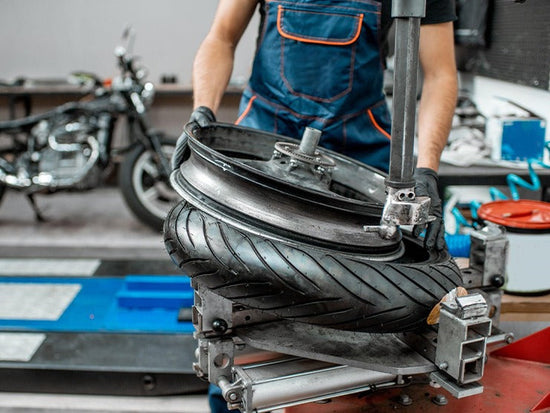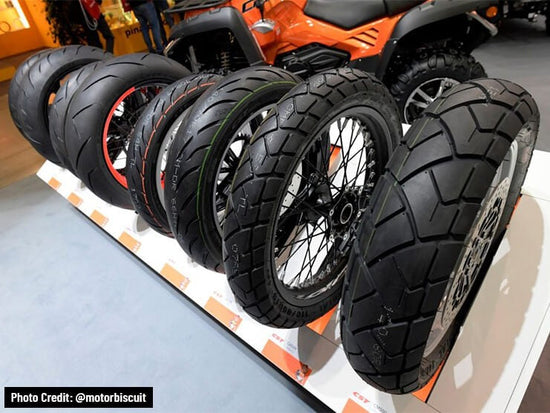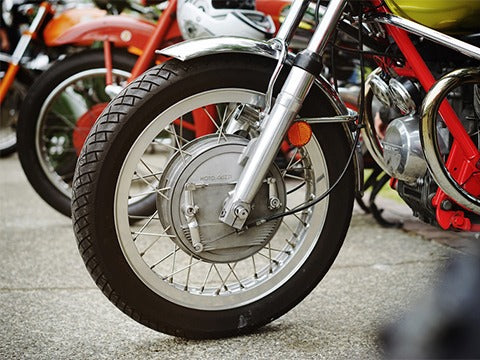Table of Content
1. All About Motorcycle Tires
If you have a better understanding of the anatomy of motorcycle tires, then you will be more likely to choose the right ones for your vehicle. Here is the list of all components of a motorcycle tire:
- Tread (Outermost layer of the tire)
- Bead (Part fits onto the rim and holds the tire in place)
- Sidewall (Part that connects the tread to the bead)
- Casing (Internal structure of the tire usually made of layers of rubber or fabric)
- Belt (Some motorcycle tires have belts fitted between the tread and casing typically made of steel or other- high-grade durable materials)
- Inner Tube (Inflatable rubber tube inside the tire and contains air)
1.1 Why Does the Motorcycle Tire Width, Matter?
Tire width matters because it affects several aspects of motorcycle riding, including:
- Stability
- Performance
- Handling
Note: Tire width measures the width of the tire tread in millimeters.
1.2 Choosing Tires By Model
Thin Motorcycle Tires
Thin tires are suitable for:
- Sportbikes
- Off-Road Motorcycles
- Dural Sport
- Lightweight Motorcycles
Wide Motorcycle Tires
Wide motorcycle tires are suitable for:
- Touring Motorcycles
- Cruisers
- Heavyweight Motorcycles
- Adventure Motorcycles
It can vary depending on the user's choice, but it is important to follow the manufacturer's manual recommendations.
2. The Physical Differences Between Wide Vs. Thin Motorcycle Tires
The physical difference between wide vs. thin tires depends on the design and construction features. Here is the list of the physical differences between wide and thin tires:
Width
Wide tires usually have a width of 180 mm or more, while thin tires have a width of 120 mm or less.
Weight
Wide tires are heavier than thin tires because they are larger in size and have heavier construction.
Aspect Ratio
Aspect ratio is the ratio of the tire's height to its width. Wide tires usually are shorter and wider, resulting in a lower aspect ratio. Meanwhile, thin tires are taller and narrower, resulting in a higher aspect ratio.
Contact Patch
The contact patch is part of the tire that touches the road. Wide tires have a larger area that touches the road than thin tires.
Tread Pattern
The tread pattern is the channels or grooves along the treads. Wide tires usually have aggressive tread patterns with larger blocks that provide comfort while off-roading. On the other hand, thin tires have smaller blocks that provide a better grip on the pavement.
Diameter
Diameter is the distance from the outer edge to the inner edge of the tire. Wide tires usually have a longer diameter than thin tires.
Profile
The profile is the shape of the tire’s sidewalls. Wide tires have a flatter profile, while thin tires have a more rounded profile.
Construction
Wide motorcycle tires are built with stiffer sidewalls and heavier construction, while thin tires are built with more flexible sidewalls and lighter construction.
Rim Size
Wide motorcycle tires require wider rims to support their larger size, while thin tires have narrower rims to support the narrow walls.
3. Differences in Features Between Wide Vs. Thin Tires
Whether it is a wide tire or a thin motorcycle tire, both have their own different physical properties that impact their working. Here is a list of the different features between wide and thin tires:
Grip
Wide motorcycle tires have a larger surface area that comes in contact with the road, ensuring a strong grip and traction, making them suited for slippery terrain.
Thin motorcycle tires have smaller contact patches, so they provide less grip but prove more responsive, nimble, and durable on the pavement.
Stability
Wide tires offer better stability and support when riding at high speed. Also, they prove best for carrying heavy loads. Thin tires are best for when you ride at slower speeds or on rough terrain.
Maneuverability
Thin tires are more agile and responsive, which makes them the right choice for technical riding. Wide tires might be less responsive but can handle different terrains.
Comfort
Wide motorcycles better absorb bumps and vibrations, ensuring a smoother and more comfortable ride. Thin tires prove less comfortable as they absorb less vibration, especially on rough terrains.
Durability
Wide tires have a heavier construction and wider treads, reducing stress on the tire walls and ensuring a longer lifespan. Thin tires may wear out more easily and quickly, especially when riding on rough terrain or abrasive surfaces.
Fuel Efficiency
Thin tires provide better fuel efficiency compared to wide tires. As thin tires have less resistance and demand less power to move, they require less fuel to turn.
Note: With the help of an appropriate tool kit, you can easily change your motorcycle tire. Read more: Tools you need to change a motorcycle tire
4. Advantages and Disadvantages of Wide Vs. Thin Motorcycle Tires
4.1 Advantages and Disadvantages of Thin Motorcycle Tires
Advantages
- Agility and Handling: Thin motorcycle tires are lighter in weight and more agile. They are easier to handle, especially when cornering, making quick turns, or swerving.
- Quick Acceleration: Thin motorcycle tires have smaller contact patches, which means there is less rolling resistance on the road. This contributes to a quicker acceleration rate.
- Fuel Efficiency: As thin tires have lower rolling resistance, they require less fuel to turn. Better fuel efficiency helps save money, especially for riders who use their motorcycles for daily commutes.
Disadvantages
- Less Traction: Thin motorcycle tires have less surface area when in contact with the road, resulting in less traction and stability.
- Less Comfort: Thin tires have less cushioning and lower shock absorption, which can result in less comfort.
- Limited Load Capacity: Thin tires have a narrow profile, making them less capable of bearing heavy loads. These tires are not suited for carrying passengers, luggage, or other heavy items.
- Reduced Lifespan: Thin tires wear out faster since the road presses into the shallow tire walls and removes the treads more easily.
4.2 Advantages and Disadvantages of Wide Motorcycle Tires
Advantages
- Better Traction: Wide motorcycle tires have a larger surface area that comes in contact with the road, providing better traction on wet or slippery roads and off-road trails.
- Improved Comfort: Wide motorcycle tires have better shock absorption and cushioning than thin tires, which ensure better comfort. You will barely notice vibrations on uneven or rough roads.
- Greater Load Capacity: Wide motorcycle tires have greater load capacity than any other type of motorcycle tire. It is highly beneficial for riders who carry passengers, luggage, or heavy items.
- Longer Lifespan: Wide motorcycle tires usually have longer lifespans, especially when they are well-maintained or not used for aggressive riding or high-speed travel.
Disadvantages
- Reduced Agility: Wide motorcycle tires are heavier and less agile compared to thin tires.
- Slow Acceleration: Wide motorcycle tires have more rolling resistance, which can result in slower acceleration.
- Lower Fuel Efficiency: Due to wide tires having more rolling resistance, this results in higher fuel consumption.
- Higher Cost: Due to their heavy construction and high-grade material, wide tires are more expensive than other motorcycle tires.
Read More: How to balance a motorcycle tire by yourself
4.3 Pros and Cons of Wide Tires Vs. Thin Motorcycle Tires
| Variation | Thin Tires | Wide Tires |
|---|---|---|
| Pros | Reduced Fuel Consumption Decreased Road Noise and Vibrations Better Traction in Snow Less Expensive More Comfortable Steering Less Rolling Resistance for Quicker Acceleration Do Not Need Heavier Springs for Suspension Leans Slightly Into a Corner at a Given Speed |
Exceptional Traction Increased Maneuverability and Handling Optimized High-Speed Durability Permits for Higher-Speed Cornering Allows You to Lean Far at Wide Angles When Cornering More Sturdy in Corners Improves Engine Control Permits Harder Throttle Application When Bent Over Permits Trail Braking Permits Hard Braking |
| Cons | Restricting Cornering Speed, Lean Angle, and Fewer Potential Side Grips Less Stablility Too Much Throttle Will Overwhelm the Small Contact Patch Provides Little or No Stopping Power For Trail Braking Permits Only Less Aggressive Braking Lacks High-Speed Safety Less Manueverable and Reduced Handling |
More Expensive Feels Heavy When Steering Leaves New Patches on the Sides (Chicken Strips) Causes the Motorcycle to Lean Further When Cornering Requires More Power for Acceleration More Mass Results in Suspensions and Brakes Working Harder Reduced Comfort Tire Sets Cost More Poor Fuel Economy |
5. Importance of Choosing the Right Tire Width
Picking tires with the right width will better ensure your safety on the road. Several factors affect the durability of thin and wide tires, but you choose the ones that best suit your riding style and follow the manufacturer’s recommendations.
When choosing between wide and thin tires, keep the following in mind:
- Long Route Tires: Wide tires are the best choice for long-distance travel, such as tours or cruises.
- Off-Roading: Thin motorcycle tires are better suited for off-roading. They provide better traction on uneven or loose terrain. Moreover, thin tires are lightweight and ensure easier maneuverability.
- Racing Motorcycle Tires: Wide tires are the better option for racing motorcycles. They have a wider surface, which ensures a stronger grip on the road. However, it is important to choose tires with the right treads and build suited for race tracks. Having wide tires also ensures faster acceleration and better fuel efficiency that complement high-capacity motorcycle engines.
Note: Make sure the width of the tire suits your motorcycle’s style, design, and construction since wide tires must be able to handle high RPMs. Meanwhile, if you are looking for thin tires, make sure your motorcycle is not too heavy for the thin tires to handle. You can also modify your motorcycle tire using the paint.
6. Conclusion
Motorcycle tires are important because their shape and size can affect your vehicle's performance. But the main factor every rider should consider while selecting a tire is the width. Choose between either wide or thin tires depending on which one best suits your motorcycle's style, size, weight capacity, shape, and model. Doing so will help you choose the best tires for your motorcycle. If you want to improve the performance, and aesthetics of your motorcycle, as you did before with the use of a leather bag, you can install aftermarket motorcycle parts such as fairings, sissy bars, crash bars, handlebars, sissy bar bags, or many more.







Leave a comment
All comments are moderated before being published.
This site is protected by reCAPTCHA and the Google Privacy Policy and Terms of Service apply.